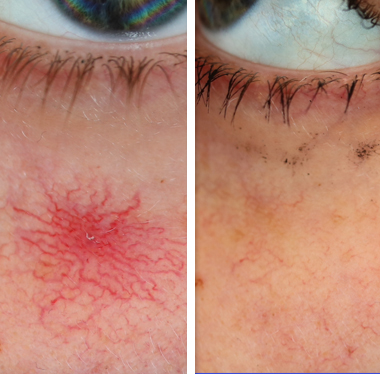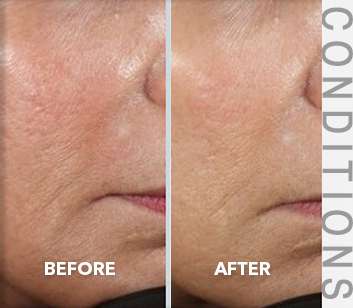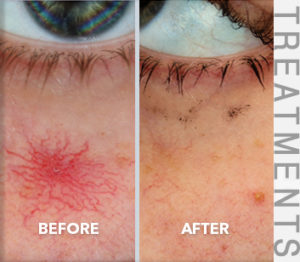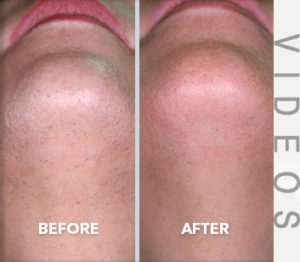Conditions
Cherry/Spider Angiomas

Results of Treatment
These little tiny bumps are very easy to remove with the vascular lasers and most are removed in a single treatment.
About Cherry/Spider Angiomas
Cherry hemangiomas are little red bumps that most commonly appear on the trunk, especially the abdomen and back, although they can appear almost anywhere. They resemble little red moles and are generally only a few millimeters in size. They often begin to appear in young adulthood into middle age. They are usually raised. People who get cherry hemangiomas seem to get more and more as time goes one. People can have hundreds of these red bumps on their trunk, extremities and head/neck. They are easily treated with lasers that target blood vessels, and most smaller cherry hemangiomas resolve in a single treatment. Immediately after treatment they turn purple and then take about 3-4 weeks to disappear.
Another common vascular condition that appears in people of all ages, but is super common in kids, is the spider angioma (also called a nevus araneus by dermatologists). As the dermatologic name implies, these small vascular clusters that are usually a few millimeters in size resemble a spider on close inspection. There is a central vessel that has numerous ‘legs’ radiating outward from it. These blanch when one presses on them. They most commonly occur on the face but can also appear on the extremities and elsewhere. Children often get spider angiomas as do many adults. People undergoing changes in their hormonal status, like pregnancy or taking birth control pills, are particularly prone to developing nevus araneuses. These spots are also quite easily treated by vascular-targeting lasers. They turn purple for a 7-10 days and then disappear in 4-6 weeks. Nevus araneuses present for more than a year may often take more than one treatment to remove.
Fortunately, these little tiny bumps are very easy to remove with the vascular lasers. Following treatment, the spots appear purple, or bruised. The bruises usually last for approximately 7-10 days, after which time they fade away. Most small cherry hemangiomas or spider angiomas are removed in a single treatment, however some larger ones may require a couple of treatments.
To answer your specific questions or schedule a consultation, call Dr Bernstein today of 610-645-5551.
Did you know?
Dr. Bernstein was the first physician in the world to use the V-Beam Perfecta® and V-Beam Prima® lasers and one of the first in the U.S. to acquire the Excel-V® laser has published numerous peer-reviewed articles on treating conditions with these lasers including Rosacea and has published extensively on their use.
Cherry/Spider Angiomas FAQs
HOW DOES LASER HAIR REMOVAL TREATMENT WORK?
The procedure uses beams of light to penetrate the skin and target the pigment in the hair shaft and induce o mild inflammatory response in the hair follicle that signals the hair to rest for o very long period of time.
WHO IS A CANDIDATE FOR LASER HAIR REMOVAL? WHO IS NOT AND WHY?
The procedure uses beams of light to penetrate the skin and target the pigment in the hair shaft and induce o mild inflammatory response in the hair follicle that signals the hair to rest for o very long period of time.
WHAT ARE THE ADVANTAGES OF LASER HAIR REMOVAL COMPARED TO OTHER METHODS?
The procedure uses beams of light to penetrate the skin and target the pigment in the hair shaft and induce o mild inflammatory response in the hair follicle that signals the hair to rest for o very long period of time.
HOW MANY LASER HAIR REMOVAL TREATMENTS DO I NEED?
The procedure uses beams of light to penetrate the skin and target the pigment in the hair shaft and induce o mild inflammatory response in the hair follicle that signals the hair to rest for o very long period of time.
IS LASER HAIR REMOVAL PERMANENT?
The procedure uses beams of light to penetrate the skin and target the pigment in the hair shaft and induce o mild inflammatory response in the hair follicle that signals the hair to rest for o very long period of time.
DOES LASER HAIR REMOVAL HURT?
The procedure uses beams of light to penetrate the skin and target the pigment in the hair shaft and induce o mild inflammatory response in the hair follicle that signals the hair to rest for o very long period of time.
WHAT ARE THE POSSIBLE SIDE EFFECTS?
The procedure uses beams of light to penetrate the skin and target the pigment in the hair shaft and induce o mild inflammatory response in the hair follicle that signals the hair to rest for o very long period of time.
WHAT AREAS OF THE BODY CAN BE TREATED?
The procedure uses beams of light to penetrate the skin and target the pigment in the hair shaft and induce o mild inflammatory response in the hair follicle that signals the hair to rest for o very long period of time.
HOW DO I CARE FOR THE TREATED AREA?
The procedure uses beams of light to penetrate the skin and target the pigment in the hair shaft and induce o mild inflammatory response in the hair follicle that signals the hair to rest for o very long period of time.
ARE MEN GOOD CANDIDATES FOR LASER HAIR REMOVAL?
The procedure uses beams of light to penetrate the skin and target the pigment in the hair shaft and induce o mild inflammatory response in the hair follicle that signals the hair to rest for o very long period of time.




